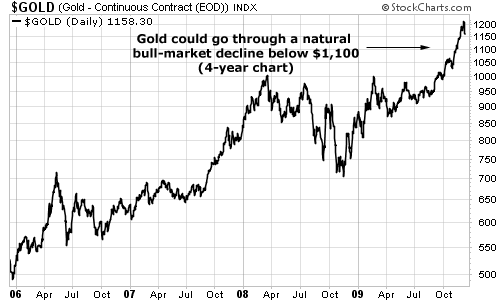| Home | About Us | Resources | Archive | Free Reports | Market Window |
What the Government Should Do to Save AmericaBy
Wednesday, December 9, 2009
"Steve, I'm borderline homeless now," my friend Lee told me a few days ago.
"I haven't paid my rent in months. My business has dried up completely. I've tried to get a real job – any job – but I don't even get callbacks. "I have my son. The feeling is just awful. Going to bed... waking up... The nightmare doesn't end. And I don't know what to do. "Steve, I hate to come to you like this. But I will do any work. Any pay above zero is good right now." Put yourself in Lee's shoes for a minute... Think about how demoralizing it must feel to lay out your situation like that to a friend. What would you do for Lee? We put Lee to work right away... I called a few friends, and we all managed to find him something to do to earn some money right now. Nothing glamorous... quite the opposite. Today, Lee is pulling weeds and mulching at DailyWealth writer Tom Dyson's house. Before that, he pressure-washed the gook off my driveway. Even better, thanks to another friend, it looks like Lee might have a more permanent job... A local roofer needs a "gofer with a truck." Fortunately, Lee drives a truck. And if that's not full-time enough, other friends can keep him earning money cleaning up jobsites and doing handyman-type jobs. So it looks like he can stay busy earning money. This work is a long way from Lee's dream. But Lee's been forced to recalibrate... to hit "reset." I'm sure he's not the only one. Officially, the nationwide unemployment rate is 10%. The number jumps to 17.2% when you consider "people employed part time for economic reasons" and "marginally attached workers." (Does Lee count as unemployed? Does temp work count? This little cartoon tries to make sense of it for you.) There are thousands of guys like Lee out there right now. What's the right way to get him back to work? What's the right way to lower the unemployment rate? In the long run, the economy – business – is the best creator of jobs. So the simple answer is, don't make it harder on businesses to create jobs. Yet government is doing the opposite... Businesses are now uncertain about their future... What will happen with taxes? Is my tax rate going up? What about my health care costs? It looks like they're going up. Am I going to face more and more regulations? What's it going to cost me to stay in compliance? Will I have to pay more for energy thanks to new energy laws? No wonder businesses aren't hiring! There's too much uncertainty... They won't hire if they're facing that kind of uncertainty and risk. I believe the right thing is for the government to stay out of the way... If the government wants to foster more jobs, putting more costs and burdens (and worst of all, more uncertainty) on the ones hiring, well, that's the wrong way to go. Wouldn't it be great if the government just said "Look, we want you to get back on your feet and hire more people. So we have a simple plan: We'll stay out of your way and cut taxes for all businesses down to 20% for three years. And your investors will pay no capital-gains taxes for three years. Yes, we want to tackle health care, environmental issues, and such. But we are intelligent enough to recognize now is a difficult time... and the best thing government can do is give you the certainty of no new health costs or environmental costs or taxes. Let's get back on our feet over three years, and then we'll look at some changes." Look, the government didn't put Lee to work. Lee put himself to work. Yes, he had to recalibrate dramatically. But he asked for work. And he found it with individuals and local small businesses. If the government gets out of the way, thousands of Lees will find work with thousands of small businesses. Government doesn't create jobs. People create jobs. The less the government interferes, the more the economy can grow... And the more people like Lee can get back to living their dreams. Good investing, Steve
Further Reading:
The Stupidity of Government Intervention Market NotesWHY THE SEASONED INVESTOR ISN'T CONCERNED ABOUT GOLD
Yesterday, we took the "long view" on gold. We saw how gold could decline all the way down to $850 an ounce and remain within the confines of a big bull market.
Today, we offer another common-sense view as an antidote to the ridiculous mainstream commentators asking, "Does the recent decline in gold mean the bull market is dead?" We take a look at the old "50% rule." The 50% rule is an old Wall Street maxim that bull-market moves often give back 50% of their gains before making a new push higher. These declines serve to shake off the latecomers and frustrate as many people as possible. Starting in September, gold made an enormous run from $955 an ounce to its December high of $1,218 – a $263 jump. Using the 50% rule, we see it would be perfectly normal for gold to decline down to $1,086. Common-sense perspectives like the "long view" and the "50% rule" leave the seasoned investor unconcerned with the recent decline in gold. 
|
In The Daily Crux
Recent Articles
|

